University community pulls together to make online transition work
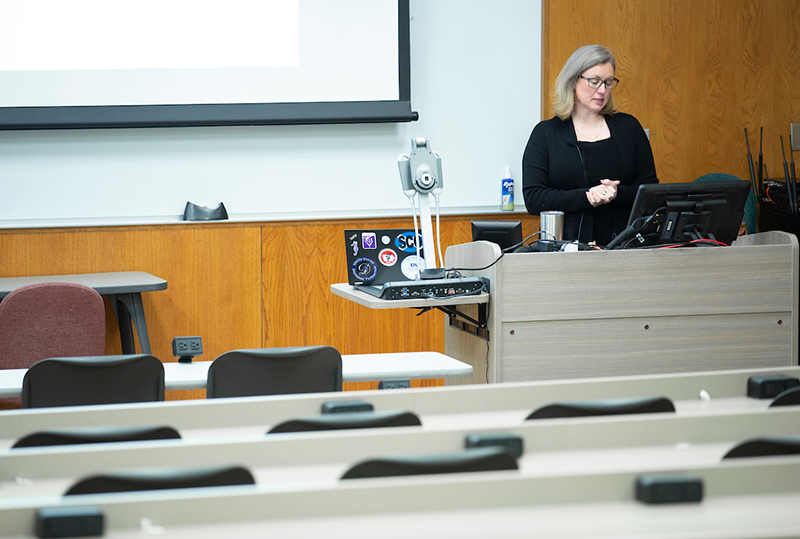
Professor of veterinary pathology Amanda Fales-Williams delivers her online lecture from an empty classroom at the College of Veterinary Medicine. Photo by Christopher Gannon.
The English department had quite a math problem.
When the university transitioned to virtual instruction, the department had little more than a week to figure out how to move 350 spring course sections online.
Associate professor Abram Anders is the director of ISUComm foundation courses English 150 and 250, one of three major multicourse programs in the department. The foundation courses involve 69 instructors and 2,688 students in 117 sections.
That was a daunting task, but did not include programs in speech communication and advanced communication, which span English 302, 309, 312 and 314. Speech communication includes 44 sections, 26 instructors and 1,056 students. Advanced communication adds 92 sections, 42 instructors and 2,132 students.
"It was a pretty mammoth undertaking, but the one thing we had going for us is chair Volker Hegelheimer has really promoted developing online courses, especially for these programs," Anders said.
Virtual visit
The College of Design is using a virtual tour offered by Davenport’s Figge Art Museum to engage industrial design students in the museum’s Henry Dreyfuss exhibition. Among its many accomplishments, Dreyfuss’ team designed the John Deere tractors of 1960.
The process
The work to move classes online began March 11, and English department leaders worked quickly to put together an FAQ and sample announcement for instructors to distribute to students. Finding ways to support instructors with varying experience levels and anticipating student needs were two major challenges.
The speech communication and advanced communication courses had an online presence under directors Anne Kretsinger-Harries and Jenny Aune, respectively, while the foundation courses were in their second semester of an online pilot program.
"It was all-hands-on-deck, and we were working 24/7," Anders said. "I didn't ask them to do that, they just did it."
The department developed work teams and pooled available online resources, including the College of Liberal Arts and Sciences online program. Anders -- along with foundation courses assistant directors Bremen Vance and Amy Walton, online instructors Carrie Anne Johnson and Brenna Dixon, and online learning coordinator Katie Fulton -- used the days before spring break to prepare information which they shared with instructors by the Tuesday of spring break.
"We needed to record a bunch of new material, and we quickly developed Week 10 and 11 modules and pushed those out to our instructors,” Anders said. “We had to create huge step-by-step tutorials to explain how to get those installed into [instructors'] Canvas sites and how to set them up correctly."
Interviews with experienced online instructors followed to learn best practices of delivery to keep students engaged in the virtual environment. To help students adjust to remote learning, Anders provided a productivity guide and schedule template. Finally, the department developed a guide with week-to-week suggestions to avoid overwhelming students or instructors.
Results
Relying primarily on Canvas, the English department was able to build its courses around easy to access and use tools. These included:
- Three- to five-minute lecture videos focused on key concepts and skills
- Video-based presentation assignments
- Video-based tutorials
- Student discussion activities
- Micro-drafting exercises to apply concepts to complete major assignments
- Peer conferencing and review of draft work through discussion boards and collaborative writing apps
CELT and ITS
The needs and capabilities of nearly every college and department are different, but they can all turn to the Center for Excellence in Learning and Teaching (CELT) and information technology services (ITS).
On March 10, 63% of the university’s spring courses had a Canvas presence, and by March 19 that number jumped to 86%. The remaining 14% were largely honors seminars, dissertation seminars or learning communities that would not be using Canvas. In about two weeks, 6,100 in-person course sections were converted to online delivery.
"A vast majority are using Canvas, but others are using tools like Zoom, Webex or some other type of online communication," said Ann Marie VanDerZanden, associate provost for academic programs.
The big undertaking started when VanDerZanden contacted department chairs who identified instructors who needed to transition their courses. That is where CELT stepped in.
With limited staff, CELT set up a virtual call center to answer instructor questions.
"We had about 15 instructional designers, and they took 20-25 calls per day," said CELT director Sara Marcketti, who supervises a staff of 13, including faculty fellows.
By chance, when last year’s polar vortex canceled classes, CELT developed a starting point for its assignment this spring. Staff compiled vast amounts of information to answer questions, provide instruction and give suggestions for quickly moving online.
"That gave us a good jump-start of thinking, 'What does it look like if campus closes?'" Marcketti said.
Questions that could not be answered on campus were handled through Canvas' 24/7 help line available to all faculty and instructors.
CELT faculty fellow for faculty programming Monica Lamm was among those doing one-on-one consultations with faculty.
"Just sharing what I am doing with my own courses has been pretty effective for most instructors," she said. “Talking to someone who is in the middle of it and getting their ideas can be very useful."
It required working seven days a week, a common theme across campus, to fuel the impressive effort.
"I think the Faculty Senate resolution really speaks to the fact that our faculty value this experience they are creating for their students," VanDerZanden said. "They are going to do everything they can to make it a high-quality, engaging learning experience."
When classes resumed March 23, online instruction was off to a strong start. According to ITS manager Korine Spengler, 3,326 Webex meetings took place that day with 14,938 participants logging 95,081 minutes. Those numbers include instructor/student, instructor/instructor, student/student and staff meetings. For the week (March 23-27), the university community logged 15,193 meetings involving 69,570 participants for 540,345 minutes.
Vet Med
The College of Veterinary Medicine had a unique challenge to move its courses online given the hands-on nature of its curriculum. In addition to lectures that no longer could be conducted in the classroom, clinical rotations occur year-round.
Courtney Vengrin, director of curricular assessment and teaching support for the college, developed a website that centralized assistance for the switch to virtual instruction. Fortunately, the college has used the Echo360 video platform for at least five years.
"Our lectures have been live-recorded," Vengrin said. "For every classroom, the live recording and audio capture starts five minutes before and ends five minutes after every class."
Vengrin helped faculty access past lectures and load them into their Canvas courses. But courses like the third-year surgery course are difficult to simulate virtually.
"We are really looking for those areas where we can prepare the students as best we can for when they are next in the classroom," she said.
Restrictions on out-of-state travel led to the cancellation of some externships and preceptorships. Instructors are working to replace those experiences.
Another hurdle with the move online is testing. When tests are conducted in the classroom, computers are locked down so no other applications can run during that time, but issues can arise with computers freezing. The college’s information technology team is available to troubleshoot, but not in the virtual setting.
"That can't happen if our students are all in different time zones, so we have discussed with faculty best practices for open-book exams rather than closed-book," Vengrin said.
Partners
Fourth-year rotations continue and consist of two-week blocks with about 25-30 rotations running at a time for 47 different blocks.
The college received help from organizations like the American Association of Equine Practitioners and American Association of Bovine Practitioners with free access to educational resources typically available only to members.
"Our partners have been great. Some of them have given us free memberships so we can use their educational resources for an entire year," Vengrin said. "That saves us thousands of dollars."
Federal law expands sick time, FMLA for virus-related leave
Beginning April 1 and for the rest of 2020, Iowa State employees will have 80 hours of additional COVID-19 sick time off available for coronavirus-related absences and the option to use the Family and Medical Leave Act (FMLA) to receive partially paid leave to cover for their children’s closed schools or child care providers.
President Wendy Wintersteen announced the expanded leave options for employees in a March 31 campus message. The policy changes conform with the Families First Coronavirus Response Act (FFCRA), a federal law enacted March 18. The two weeks of extra sick time, which are prorated for part-time employees, are in addition to and separate from existing accruals of sick time, vacation and emergency time off.
The pay rate for the COVID-19 sick time off depends on how it is used. COVID-19 sick time (self) is used when faculty or staff must miss work due to their own coronavirus symptoms, medical risks or required quarantine. It is paid at an employee's usual rate, up to $511 per day (which equates to an annual salary of about $133,000).
COVID-19 sick time (family) is used to care for a family member self-quarantined due to coronavirus concerns or for parents and guardians providing child care because a school or child care provider closed due to the pandemic. The pay rate in these situations is two-thirds of an employee's usual pay, capped at $200 per day (which equates to two-thirds of an annual salary of $78,000.)
Employees caring for their children missing school or child care due to virus-related closures also can elect to take up to 12 weeks of COVID-19 FMLA leave. FMLA leave is usually paid only with the applicable sick, vacation or emergency time off employees have accrued. When FMLA leave is taken for child care reasons under the FFCRA's temporary expansion, the final 10 weeks are partially paid without affecting employee time off balances (at two-thirds an employee’s usual rate, with the same $200 daily limit).
A flowchart produced by university human resources (UHR) can help employees figure out the leave options available in their specific situation. UHR established a website with COVID-19 resources and plans to post a recorded webinar about the changes to Learn@ISU later this week.
Employees with questions about the expanded time off and leave options can contact their HR service delivery team at hr_delivery@iastate.edu.
Regents greenlight faculty P&T requests
Meeting online April 1, the state Board of Regents gave the final green light to promotion requests for 98 Iowa State faculty members, a 40% increase over last spring's faculty promotions. The table breaks down the total by college and promotion type.
2020-21 Faculty promotions and/or tenure
|
College |
To professor |
To associate professor |
|
AGLS |
10 |
5 |
|
Business |
2 |
5 |
|
Design |
1 |
4 |
|
Engineering |
6 |
10* |
|
HS |
4 |
9 |
|
LAS |
13 |
19 |
|
Vet Med |
3 |
7 |
|
Total |
(19 female, 20 male) 39 |
(30 female, 29 male) 59 |
*Includes one tenure-only award (to an associate professor)
Each spring, in concert with faculty promotion requests, the three regent universities submit an update on the makeup of their faculty. The data on Iowa State faculty is shared in the table.
ISU faculty
|
|
2019-20 |
2018-19 |
2017-18 |
|
Tenured |
966 (51%) |
986 (51%) |
979 (50%) |
|
Tenure-track |
343 (18%) |
369 (19%) |
383 (19%) |
|
Non tenure-track |
601 (31%) |
578 (30%) |
604 (31%) |
|
Total |
1,910 |
1,933 |
1,966 |
Vet lab clears final approval
The board approved a budget ($75 million) and schematic design for a new two-story, 72,000-square foot Veterinary Diagnostic Laboratory, clearing the way to begin construction later this fall. Interim senior vice president for operations and finance Pam Cain told board members the new facility will provide about 50% of the space needed to house all VDL functions, so the design allows for a future addition.
The university removed from the agenda a budget and schematic design for the athletics department's proposal to expand the north and south concourses at Hilton Coliseum.
New P&S pay grades
In the consent agenda, the board approved the compensation structure in Iowa State's new classification/compensation system for the approximately 3,200 professional and scientific employees. Implementation is underway for the new system and currently targeted to wrap up in late May. Its 15 market-based pay grades use a fanned approach to grade widths, with lower grades being narrower and higher grades becoming progressively wider to account for greater market variability in higher-level jobs. It replaces a system developed in 1993 for internal equity.
Parking permit increases
Employee parking permits will go up about 3% on July 1. The increases are $6 for general staff permits, $17 for reserved permits and $30 for 24-hour reserved spots. Employee motorcycle permits will go up $2. The hourly price for parking meters and metered lots will stay the same ($1).
Permits for the Memorial Union ramp, which is not part of the university's parking division, will go up about 2.5%. The MU changes vary from a $5 increase for a summer permit to a $15 increase for an annual permit.
Hourly parking in the MU ramp will go up 25 cents per hour, with the daily maximum rising from $13 to $15. The price of the first hour rises to $2.25, additional hours 2-5 rise to $1.75 per hour, and hours 6-8 rise to $1.50 per hour. Special fees, for example illegal exit or lost ticket charges, will remain at current rates.
July 1: Parking increases
|
Permit |
FY 2021 |
Current |
|
24-hour reserved |
$1,005 |
$975 |
|
Reserved |
$582 |
$565 |
|
General staff* |
$186 |
$180 |
|
Departmental |
$217 |
$210 |
|
Vendor |
$325 |
$315 |
|
Motorcycle (employee) |
$62 |
$60 |
|
Memorial Union ramp |
|
|
|
Annual |
$585 |
$570 |
|
Fall or spring |
$256 |
$250 |
|
Winter (Nov-Feb) |
$250 |
$244 |
|
Summer |
$207 |
$202 |
*Includes lots designated for residence department and Ames Lab
Other ISU items
The board also approved Iowa State requests to:
- Set student residence system rates for the next 18 months. Rates in most residence halls and apartments for this summer and the 2020-21 academic year won't change but will go up 2% for summer 2021 (hall increases range from $24 to $35 for the summer; apartment increases from $21 to $39). The exception is Wallace and Wilson halls ("the towers"), where room rates are going down 11.5%-18.2% ($526-$1,010) to encourage students to live in those halls.
- Increase student meal plans and flex meal plans 1% on July 1. The guest price in the dining centers will go up 10 cents for breakfast (to $10.60) and 15 cents for lunch and dinner (to $13.65).
- Offer a new undergraduate degree, B.S. in environmental engineering, in the civil, construction and environmental engineering department, beginning this fall.
- Award an Honorary Doctor of Science degree to ISU alumnus Subra Suresh, president of Singapore's Nanyang Technological University, former president of Carnegie Mellon University (2013-17) and former head of the National Science Foundation (2010-13), for outstanding contributions as a distinguished engineer, scientist, entrepreneur and leader in higher education. No date has been set to make this award.
- Award an Honorary Doctor of Humane Letters degree to ISU alumna Beth Ford, first female president and CEO of Land O'Lakes Inc., to recognize her contributions as a pioneering leader in business and agriculture and advocate for farmers and rural communities. No date has been set to make this award
- Sell the Fick Observatory, 45.3 wooded acres and three observatory buildings four miles southwest of Boone to adjacent property owner Aaron Gillett for $339,870. The observatory has been inactive since 2008.
Board leadership
The regents unanimously reelected Mike Richards and Patty Cownie to serve as board president and president pro tem, respectively. Their two-year terms begin May 1 and run through April 30, 2022.
Some summer orientation content will move online
The COVID-19 pandemic has compelled another significant student activity to find a home online -- at least partially. New Student Programs (NSP) director Sarah Merrill alerted families Monday that elements of June orientation for first-time students will be conducted online. And, to provide extra time for students to connect on campus, the NSP staff will add an optional "Week of Welcome" program to students' August move in.
Merrill said it was a difficult decision to make, but necessary for a positive move forward.
"By making this decision now, we'll have more time to develop a top-notch experience for our students," she said.
University leaders signed off on the NSP proposal late last week.
June and August components
New students will be invited to complete some orientation tasks online, at their own pace but within a June 1-26 window. Family members also will have access to many of the online materials. When students have completed the online content, covering topics such as ISU campus resources and effective planning for college, they'll schedule a virtual appointment with their academic adviser and, subsequently, register for fall classes.
"It takes the entire campus community to provide a meaningful orientation for 14,000 people, an experience that confirms for our students and families they have made the right choice," Merrill said. "We are so grateful to our campus partners – in the academic division and in student affairs – for being open to another new twist this spring. We will move forward together."
New students -- and family members -- will be invited to arrive early on campus for welcome activities Aug. 17-19, prior to the annual Destination Iowa State days Aug. 20-22. Traditional June experiences moved to August will include academic orientation sessions, resource fair, campus tours and student ID cards. Students who participate in the three welcome days also will have the option of moving into campus housing earlier, on Saturday-Sunday, Aug. 15-16.
Merrill said her team will spend this month developing virtual programming and determining logistics for June and August. In early May, they'll be ready to share details about orientation and the additional welcome event.
Athletics department shares budget strategies
The athletics department announced Wednesday several steps it is taking to respond to financial challenges caused by the COVID-19 pandemic. In an open letter to Cyclone fans, director Jamie Pollard outlined six actions, including a one-year, temporary pay reduction for coaches and certain staff as well as a freeze on ticket prices.
"These actions will help us address the $5 million shortfall that we face with the cancellation of the NCAA and Big 12 Men's Basketball Tournaments," Pollard wrote. "It was also important to us to provide our loyal ticket holders and donors some relief in regards to ticket prices and donations."
The athletics department is almost entirely self-sustaining, relying primarily on ticket sales, donations and Big 12 Conference television revenues and sponsorships. It does not receive state appropriation dollars.
"I appreciate Jamie's leadership and the efforts of the athletics department in implementing these actions," said President Wendy Wintersteen. "The COVID-19 crisis is impacting the entire university; however, its effects are being felt more immediately on units and departments that do not receive state funding. It is important that these units have the flexibility to take immediate and necessary steps to reduce their expenses."
ISU Dining pivots to provide pickup service
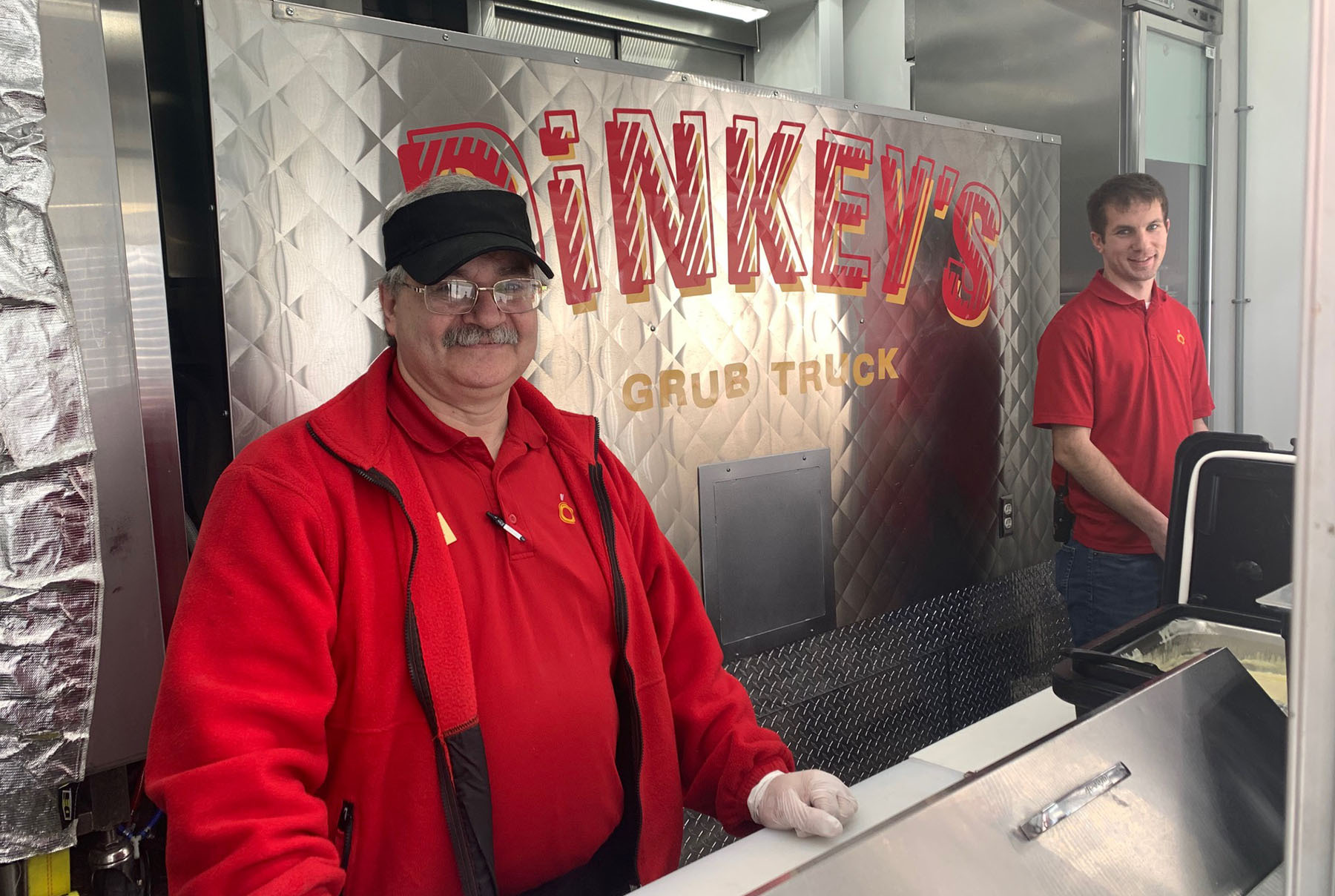
ISU Dining's food truck is being used to provide on-site daily afternoon snacks for students still living in the residence halls. Food service managers Carl Chumos, left, and Ryan McGowan were handing out nachos when the service debuted Wednesday.
What does it take to feed about 500 students still living in the residence halls? A monumental shift from serving thousands of meals daily at 26 campus venues, to providing daily pickup service at three designated locations.
"Reality hit us very quickly," said Karen Rodekamp, assistant director of engagement in ISU Dining. "Our team has worked to stay ahead of the next governmental guidelines, always trying to see into the future."
That proved to be the case when Gov. Kim Reynolds issued a March 17 statewide mandate prohibiting dine-in eating.
"We found out at 10:30 a.m. that at noon, dine-in would no longer be an option. We were proactive when we saw what was happening in California and New York, and we already had about 30,000 to-go containers ready. We were able to switch over in a heartbeat," Rodekamp said.
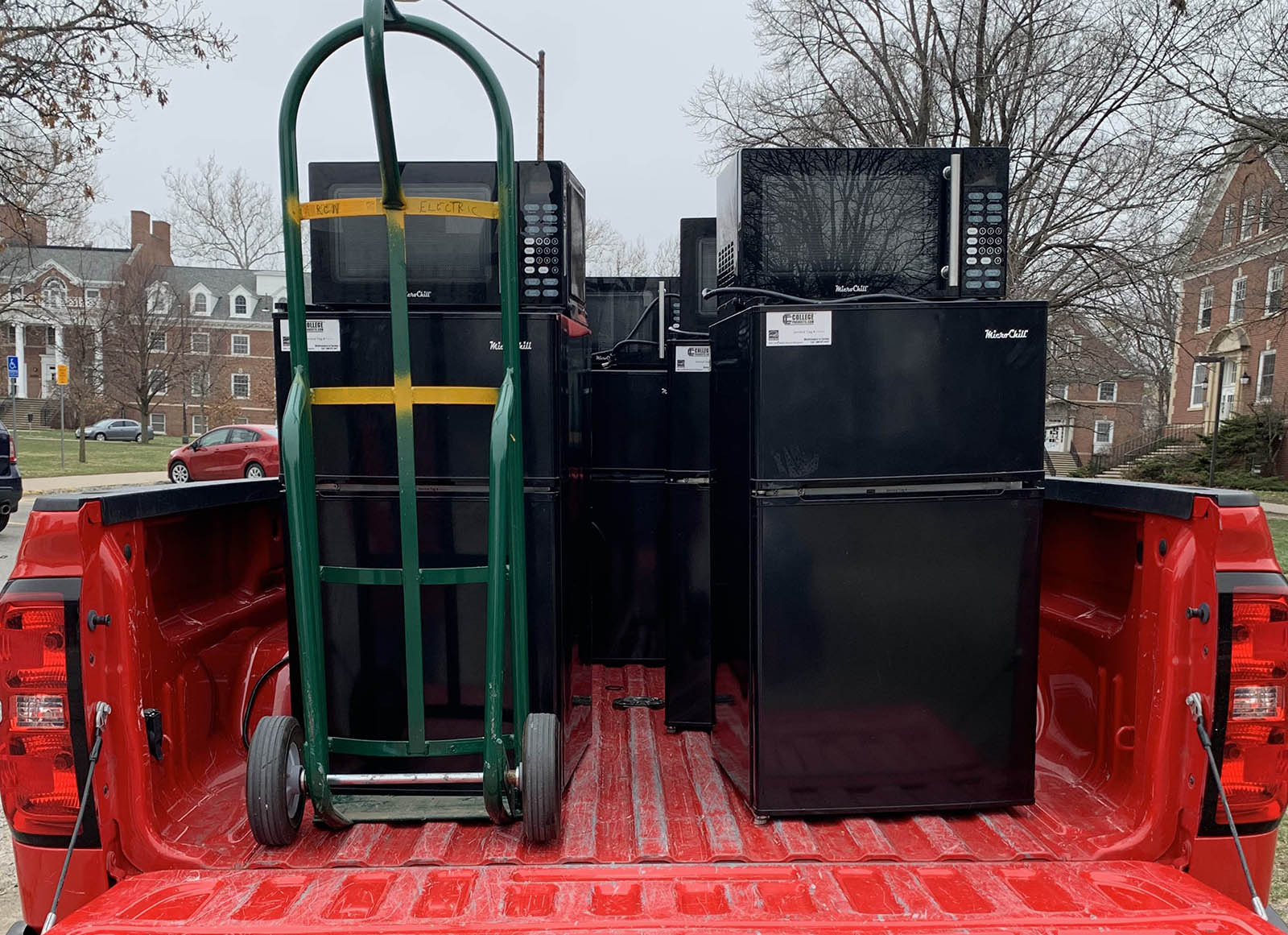
Nearly 100 MicroFridge appliances -- a microwave, refrigerator, freezer combo -- were delivered to students who need them to store and reheat pickup meals. Contributed photo.
How does it work?
Rodekamp said the pickup service is primarily for students living in residence halls who are required to have one of four dining plans -- Cardinal, Cyclone, Gold and CyFlex -- and students living in Wallace-Wilson who have a broader range of meal plans.
The first order of business was to make sure the students were able to store and heat their pickup meals. Residence department staff located and delivered nearly 100 MicroFridges -- an appliance with a combination microwave/refrigerator/freezer -- by the March 26 start date for pickup service.
Students choose a week's worth of dining via a Qualtrics form, then get up to three complete meals -- lunch, dinner and tomorrow's breakfast -- in one daily trip to their designated pickup spot. Locations are Friley Windows, Seasons Marketplace and Storms Dining, with pick up available from 11 a.m. to 1 p.m.
The culinary team prepares the food and cools it quickly in a blast chiller, then the packaging team creates individual meals in microwaveable containers. When 15 of ISU Dining's 19 retail locations were shuttered, those food and drink inventories were added to the mix. Snacks, for example chips and candy bars, also are included in the pickup meals.
"We throw treats in the bag, just little bonuses," Rodekamp said. "Not only do they get a meal, but they get snacks in there, too."
Limiting risk
ISU Dining switched to pickup service to make it safer for their employees and students. It also provides an established, safe method to continue service if a shelter-in-place order is issued.
"We flipped the service to limit contact, create distance and keep people out of a facility with high-touch surfaces such as ketchup pumps and pop machine buttons," Rodekamp said. "We want to be ready to serve the students to the best of our ability and limit, as much as possible, the need to travel outside their residential facility."
ISU Dining workers are following safety recommendations while preparing and packaging the food.
"We certainly have increased our precautions, and our standards are transforming almost daily. We have a quality assurance and food safety manager who has been with us every step of the way," Rodekamp said.
Bonus snacks

Afternoon snacks delivered daily to residence hall areas via Dinkey's food truck include nachos, soft pretzels and hot dogs.
Beginning this week, the Dinkey's food truck is bringing a snack to residence areas such as Maple-Willow-Larch, Wallace-Wilson towers and Friley. Rodekamp said the truck will visit locations daily with "bonus snack options" such as nachos, hot dogs and soft pretzels with cheese.
"Those students can come get a whole new snack option as a study break in the afternoon. It won't deduct meal swipes, it's just a good-will measure to keep their spirits and morale up, and to show that ISU Dining is here for them," Rodekamp said.
Other food options on campus
Limited grab-and-go service still is available in a handful of locations, too. Operating times and venues are available on the ISU Dining website.
"We have four retail service locations to service those students who have more retail-based plans and staff who are essential or remain on campus," Rodekamp said. "We increased the range of grab-and-go sandwiches, salads and other items at locations that typically don't provide many of those options."
Rodekamp said ISU Dining donated its overstock of perishables to the Food at First community food bank to eliminate food waste, and plans to donate its overabundance of coffee to front-line COVID-19 locations, including medical centers.
Help for your home office
User guides
More than 30 user guides related to online working and learning are available on the ITS remote work webpage. The links lead to self-help articles in the IT knowledge base, which is searchable for support on many technology issues.
Although the commute may be shorter, there still are challenges for employees who are working from home. In addition to the information compiled on the ITS remote work resources website, here are some tips and tricks for your off-campus office.
VPN: What is it, and do I need it?
A connection to ISU's virtual private network (VPN) is NOT required for web-based applications like Workday, Webex, Cybox and Microsoft Outlook. The VPN can be overwhelmed by users who don't need it and should only be used to provide encrypted remote access for services like ADIN. Local IT support can help remote workers determine if they need a VPN connection.
Personal rooms on Webex
All ISU employees have "personal" meeting rooms on Webex -- a virtual office space with a permanent online address (https://iastate.webex.com/meet/yourNetID). For example, this could serve as a meeting space for students to connect with faculty or advisers during established office hours. Users can invite others to their personal room or request access to a colleague's room without setting up a meeting request through Outlook. Request notifications are delivered via email and must be accepted before visitors can enter personal rooms, which can be locked and unlocked for privacy.
Lighten the internet load
If you have unreliable internet access or a house full of people taxing your bandwidth, skip the video during online meetings. Users can turn off their own video feed in Webex and Zoom. To opt for an audio-only Webex feed of all participants, deselect "Show Participant Video" in the "View" drop-down menu.
Connecting from anywhere
Worried about your internet data limit? Most internet and telecommunications providers have joined the Federal Communications Commission's Keep Americans Connected initiative, pledging to provide unlimited high-speed service during the pandemic. Some also are raising data speeds, offering free services for students and low-income households, and enabling WiFi hot spots. Check with your internet and cellular phone providers to find out more.
When things seem S-L-O-W
Having connectivity issues with Canvas? Can't log in to your Okta dashboard? ITS established a webpage that identifies hiccups in campus services and networks. The system status page displays current and previous service interruptions, and planned maintenance on the horizon.
Help when you need it
The IT solution center is operational with staff working remotely. Service requests can be submitted by email (solution@iastate.edu), via the ServiceNow incident portal, or by voicemail (294-4000). The Center for Excellence in Learning and Teaching (CELT) website provides help with 24/7 Canvas support, a CELT response team and contacts for unit-specific support.
Researchers, lab staff step up big with donations
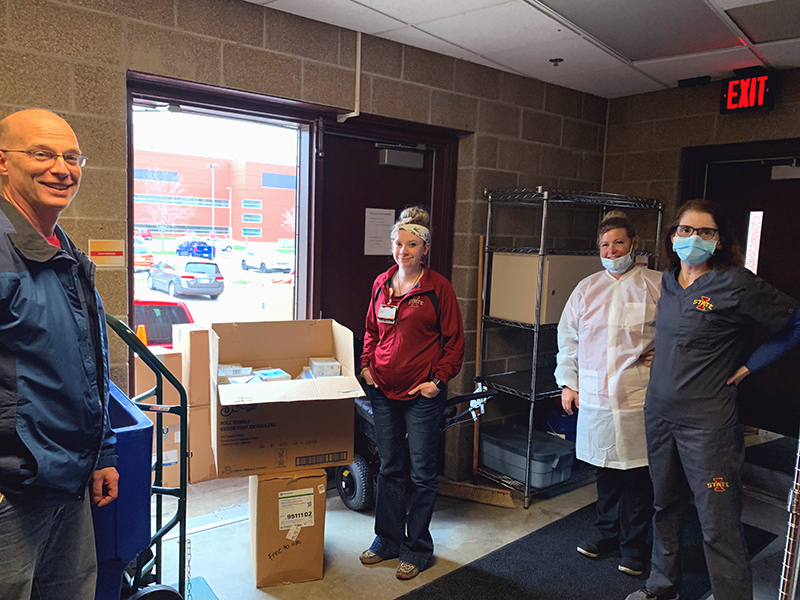
Associate director of environmental health and safety Bill Diesslin delivers donated personal protection supplies to the Thielen Student Health Center staff Friday. Pictured (l-r) are Calyn Tope, Emily Swenson and Julie Halbur. Image supplied.
Wolfgang Weber occasionally needs an N95 respirator, but he donated nearly a full box of the precious protective masks last week. Weber, who runs a teaching lab in the biomedical sciences department at the College of Veterinary Medicine, said some of his tasks create bad dust -- grinding up bones, for example.
However, when the call went out from the provost's office for a campus effort to inventory and collect about 10 varieties of protective equipment for local health care workers on the front line of the COVID-19 battle, he didn't hesitate.
"It's a priority thing. What they need them for is much more important," Weber said, adding he'll improvise the next time he needs a mask.
Weber's story is one of dozens across campus, as faculty and staff round up gloves, disposable gowns, safety glasses, hand sanitizer, face shields, surgical masks -- and the elusive N95 respirators -- in their research and teaching labs. Staff in environmental health and safety (EHS) created an online spreadsheet and invited the campus community to populate it. In the first 24 hours, there were 90 entries. By early this week, there were 178. It includes entries as small as "3 face shields" to one offering nitrile gloves: "3200 XL, 5800 L, 3000 M, 5800 SM."
Chinese gift
Luqiao "Allen" Yu, an ISU alumnus who returned to his native China, was connected to Diesslin via the alumni association and asked how he could help. Yu, with help from 17 friends, rounded up 5,000 surgical face masks and 200 face shields and shipped them March 31 from Ningbo to Ames via airmail -- with a promise to find surgical gowns soon. Each box was sealed with the wrap, "Go Cyclones."
EHS associate director Bill Diesslin, who also serves on the university's COVID-19 workforce protection working group, is managing the list and the effort to get protective supplies into the right hands. Every entry is a winner, he says.
"It's overwhelming how much generosity there is on our campus," he said. "It's nice to witness something like this."
For now, there isn't a central stockpile forming anywhere on campus. From the spreadsheet, Diesslin knows the types of supplies offered, quantities, where they're stored and how to contact the owner when the time is right. Last Thursday, he sent a request to deliver three especially scarce items to the EHS Building: disposable surgical gowns, face shields and N95 respirators. When he arrived at work the next morning, an unopened case of surgical gowns was among the supplies already dropped off.
ISU's Thielen Student Health Center is the first place the donated supplies go.
"I take my lead from the leaders in student health," Diesslin explained. "They tell me what they need to safely do their jobs. I find it on the list, and then I go get it for them."
Diesslin said he coordinates frequently with Story County Emergency Management leaders in preparation for a larger COVID-19 outbreak. If and when that time arrives, he will consult the spreadsheet and start retrieving donations from across campus.
Vet Med secures sanitizer with network of helping hands
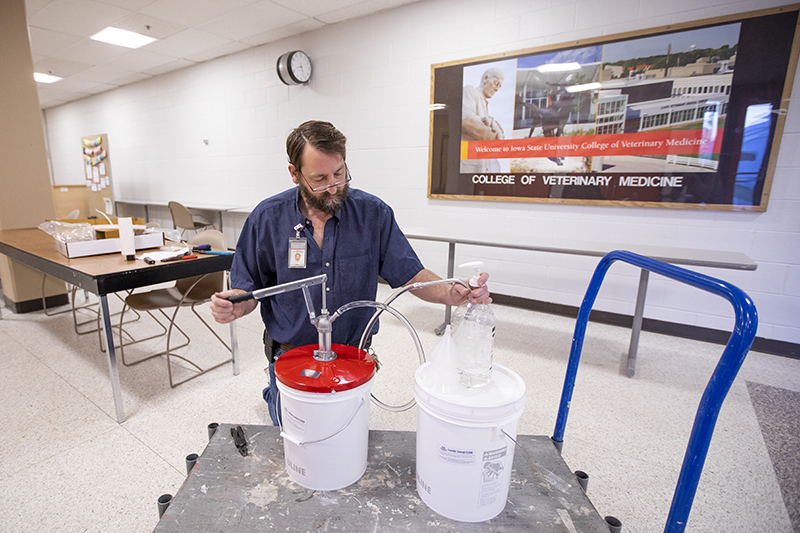
Brian Adams, facilities manager at College of Veterinary Medicine, fills pumps with hand sanitizer on Monday. The college purchased 30 gallons of hand sanitizer from a distillery in Bancroft. Photo by Christopher Gannon.
S&B Farms Distillery usually makes whiskey, the College of Veterinary Medicine (CVM) usually has no trouble finding hand sanitizer and the former usually has nothing to do with the latter.
But lately, there's nothing unusual about cooperating to overcome unexpected challenges, which is how a network of helping hands on campus and beyond assisted the Bancroft, Iowa, distillery in supplying Vet Med facilities with needed sanitizer last week.
"This is truly an example of Iowans working together to address issues in a very challenging situation," said Renee Knosby, the college's operations director.
Hand sanitizer was one of the first products that became difficult to find in the coronavirus crisis, with stores selling out well before the virus was detected widely in the U.S. Knosby said the college began trying to replenish its sanitizer inventory on March 2, acting on concerns a Vet Med faculty member expressed about COVID-19. Sanitizer was on back order already. By March 20, supply was getting low at CVM facilities.
Since the H1N1 influenza outbreak a decade ago, the college has stationed hand sanitizer dispensers near its classrooms and throughout the Lloyd Veterinary Medical Center and the Veterinary Diagnostic Laboratory. Typically, the hospitals alone go through about two gallons per month, but usage is roughly double that right now because hygiene practices are heightened and personal protective equipment is being conserved for human health care, Knosby said.
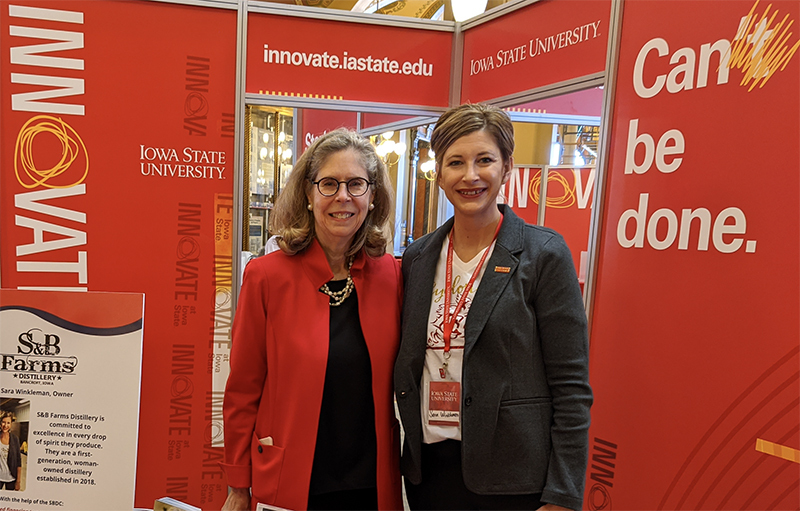
President Wendy Wintersteen with S&B Farms Distillery owner Sara Winkleman at ISU Day at the Capitol on March 5. Photo by Stacy Dreyer.
CVM dean Dan Grooms, in hopes of finding some leads on sanitizer sources, inquired with Iowa State's other deans. Ivy College of Business dean David Spalding referred CVM to Lisa Shimkat, state director of America's SBDC Iowa, the statewide small business development center hosted by the Ivy College.
Shimkat had been working with S&B Farms owner Sara Winkleman as the distillery rapidly shifted its stills to begin making alcohol for sanitizer about two weeks ago, after federal regulators gave distilleries emergency approval to produce hand sanitizer.
"We decided this is our way we could step up and help out," said Winkleman, who was named the 2019 Deb Dalziel Woman Entrepreneur of the Year by America's SBDC Iowa and participated in ISU Day at the State Capitol last month.
The distillery turned to the SBDC for support in tracking down some of the required ingredients for sanitizer that also are difficult to locate now, such as glycerin, a thickening agent.
"It's been above and beyond," Winkleman said of the SBDC's assistance. "They've been nearly a godsend to me."
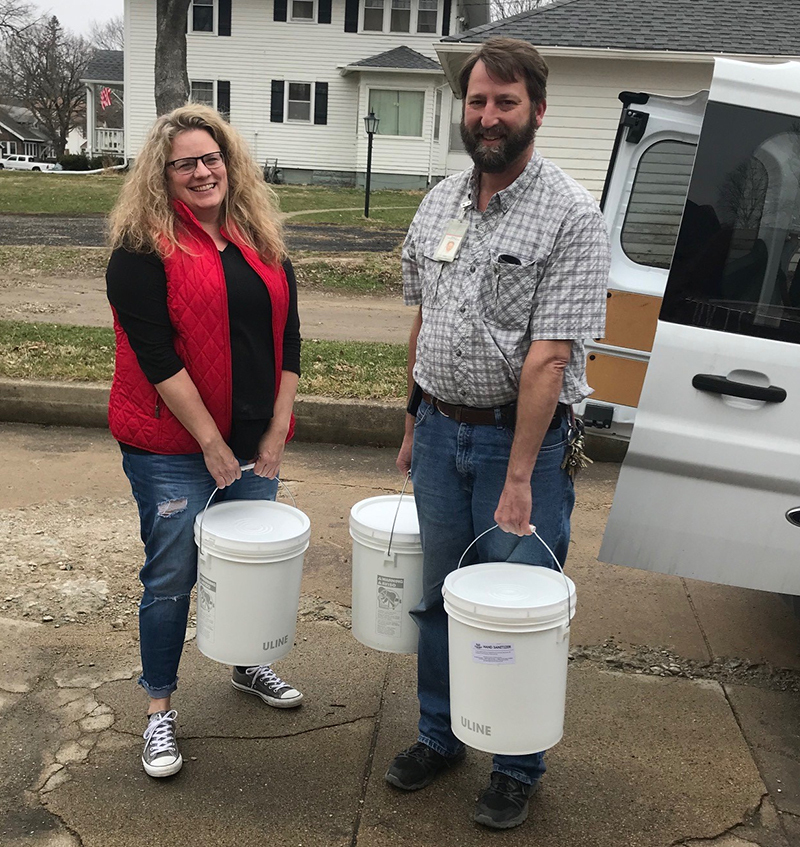
Lisa Shimkat, state director of America's SBDC Iowa, hands off a load of hand sanitizer to Vet Med facilities manager Brian Adams. Photo by Lea Schorzmann.
Shimkat said the SBDC was happy to do its part.
"The only way to make a difference is to step up and make it happen," she said. "That is what everyone did, and we were lucky enough to be a part of it."
SBDC staff also helped S&B Farms find a supplier for extra ethanol to keep up with the staggering demand the distillery is seeing from health care and emergency personnel in the region.
"We are inundated on orders," Winkleman said. "The calls are nonstop."
Vet Med's order was for 30 gallons, and it was delivered as collaboratively as it was produced. Shimkat picked up the six 5-gallon buckets March 25 in Bancroft, more than an hour north of her Fort Dodge home. CVM facilities manager Brian Adams drove to Fort Dodge to haul them back to the Vet Med campus.
Knosby said the sanitizer should last the college for two to three months.
"Maintaining the continuity of the public's access to animal health care services provided by all of these units is essential and critical," she said.
The latest on campus impacts of COVID-19
The unprecedented response to the COVID-19 pandemic evolves rapidly. Campuswide communication and regularly updated FAQs -- including one specifically for employees -- are available on the campus safety page. Each week as needed, Inside Iowa State will recap how coronavirus is affecting the university and share relevant resources for employees. On April 2, here is what Iowa State faculty and staff should know:
Leave changes
In a campus message March 31, President Wendy Wintersteen announced an expansion of the leave and time off available to employees impacted by the coronavirus, including a separate 80-hour bank of sick time to use this year and an option to take partially paid family leave to provide child care for children whose school or child care provider closed. A university human resources (UHR) flowchart can help faculty and staff figure out how these changes may impact their personal situation.
Resources and support
UHR established a website for sharing information connected to COVID-19, including job aids on how to account for the additional time off and leave options in Workday. Information technology services revamped its remote working website, adding direct links to short instructional articles on tools for working, learning and teaching remotely. Check out Inside's story this week for additional tips and tricks for working from home. ISU WellBeing's updated website includes links to its weekly sessions on mindfulness and well-being as well as the campuswide Keep Community, Stay Informed, Be Well wellness campaign.
Academic affairs
The Center for Excellence in Learning and Teaching, a vital part of the innovative effort to quickly shift thousands of courses online, has an FAQ for quick answers to faculty's most common questions about the transition. Guidance released March 30 by the provost's office provides graduate and veterinary medicine students the same option as undergraduates to take impacted courses on a pass/not pass basis for full credit. A provost's office FAQ gives more detail on a one-year tenure-clock extension offered to faculty affected by the pandemic.
Town hall
A March 30 senior leader online town hall for employees was recorded and posted online after the initial attempt at holding it live encountered technical difficulties. Wintersteen thanked faculty and staff navigating the challenges of working from home and those who continue to perform essential services on campus. "For all of us, this crisis has impacted our lives in a unique set of ways. We all need to recognize that and support each other as we adapt to this changing environment that we find ourselves in. So thank you for everything that you're doing. Thank you for your ability to adapt and be resilient. I recognize how difficult this is," Wintersteen said. Questions employees hoped to pose during the town hall can be submitted by email. Send HR questions to HR_delivery@iastate.edu and all other questions to COVID-19@iastate.edu.
Student impact
New student orientation, usually held throughout June, has joined the list of events and activities shifting online. Incoming students will get a longer chance to connect with ISU the week before classes start in August. Dining and residence staff continue to adjust how they serve students who remain in campus housing. Students who aren't returning to campus this spring will receive refunds for a portion of their room and board fees, Wintersteen announced in a March 30 campus message. Students and employees who lack internet access can connect to university Wi-Fi from their vehicle on the east side of Jack Trice Stadium.
Status of spread
As of April 1, four of Iowa's 549 test-detected COVID-19 cases were in Story County, according to the Iowa Department of Public Health (IDPH). See the state's coronavirus website for updated information on confirmed cases and hospitalizations in Iowa. Two of the Story County cases were announced April 1. The two Story County patients diagnosed previously are doing well, with one already recovering and out of quarantine, assistant vice president for student health and wellness Erin Baldwin said during the March 30 town hall. ISU officials are in daily contact with IDPH and Mary Greeley Medical Center and will keep the campus community informed to the extent possible about any cases connected to Iowa State.
Here to help
Iowa State faculty and staff are offering up personal protective equipment for local health care workers to use in the face of shortages. An ISU lab staffed largely by student employees is making 3D-printed face shields for health care workers across the state. The Center for Industrial Research and Service is coordinating requests for Iowa State assistance with manufacturing needs related to the pandemic. Faculty and staff who receive such a request should send it to ciras.info@iastate.edu. ISU employees who want to help and have relevant research capabilities -- such as medical device manufacturing, rapid factory changeover or 3D printing -- should contact Jake Behrens at jbehrens@iastate.edu.
Drive-up Wi-Fi available outside Jack Trice Stadium
Information technology services (ITS), in partnership with the athletics department, temporarily has enabled drive-up Wi-Fi service on the east side of Jack Trice Stadium. Effective March 31, those with an active ISU Net-ID can park in lot S7 (near gate 2) and use their ISU credentials to connect to the Eduroam network from their vehicle.
While the best connectivity likely will be in lot S7, lots 85E (northeast of stadium) and S3 (southeast of stadium) are alternate locations for accessing the network. Users will experience better Wi-Fi connectivity the closer they are to the stadium but are asked to use existing parking stalls when accessing the service. Once parked, simply connect your device to the Eduroam Wi-Fi network using your Net-ID and password.
"As campus has continued to transition to online courses and remote work, we have looked for opportunities to provide resources to improve the experience for students, faculty and staff," said Mike Lohrbach, director of enterprise services and customer success for ITS.
The service is designed to provide reliable internet to those who do not have access to it. Those who use this service are reminded to practice social distancing and either stay in their cars or maintain at least 6 feet between Wi-Fi users.
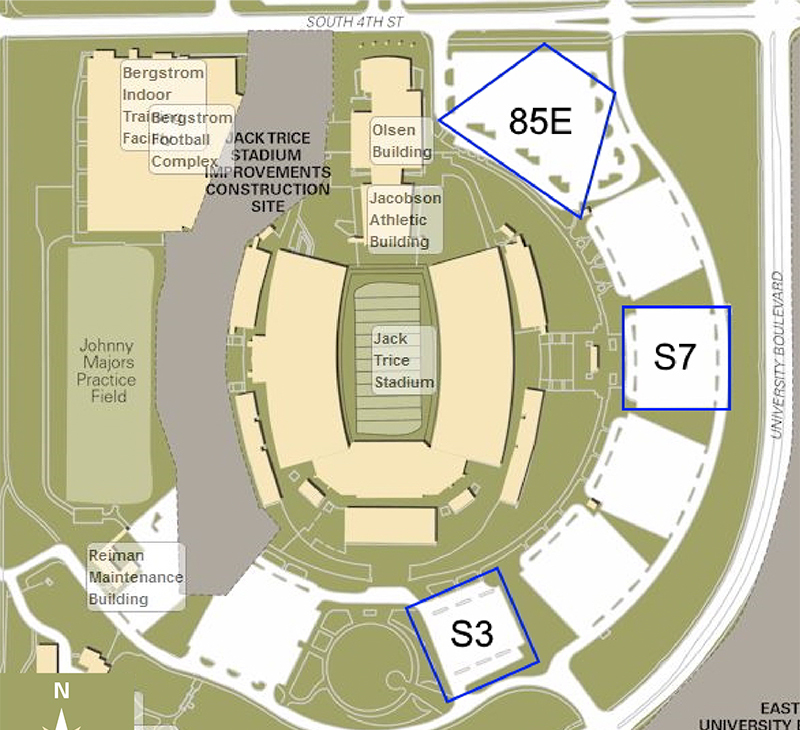
Lots S7, S3 and 85E, adjacent to the east side of Jack Trice Stadium, are the best locations from which to access Wi-Fi service.
